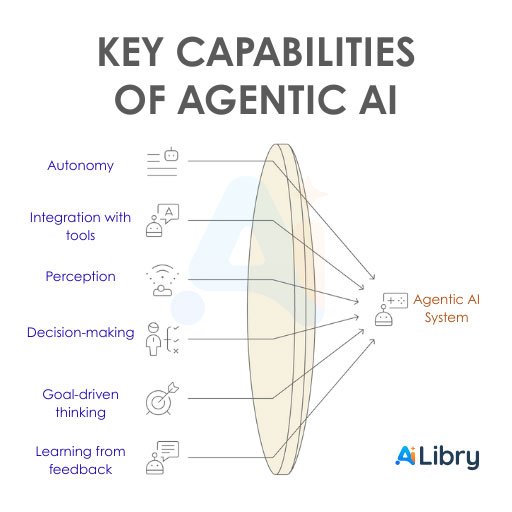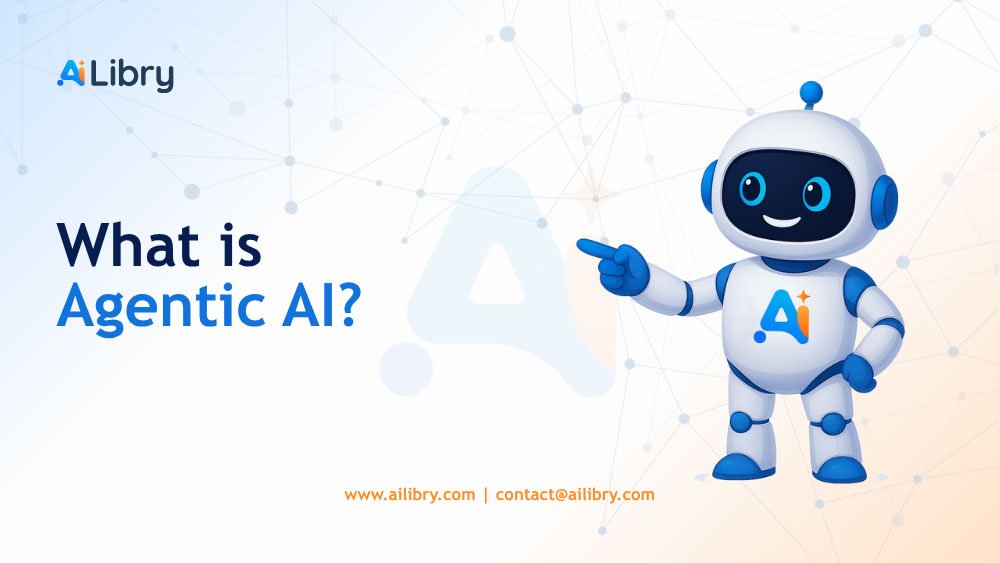You tell your assistant, “plan my travel for next month.” It checks your work calendar, books flights, finds a hotel near the meeting, arranges a rental car, and sends you the full itinerary. No extra instructions. No follow-ups.
That is agentic AI in action. It doesn’t just wait for step-by-step orders. It understands the goal and works out the details.
Think of it like a colleague who knows your preferences and handles the whole task without you having to explain each move. You decide what needs to be done. It figures out how.
Definition and Core Idea
Agentic AI is artificial intelligence that can take action toward a goal without constant human input. Instead of waiting for a specific command, it works out what needs to be done and follows through.
Traditional AI is reactive. You give it an instruction, and it responds. Agentic AI is proactive. You give it an outcome, and it figures out the steps on its own.
The term “agentic” comes from the word “agent,” meaning something that acts with purpose. These systems can decide, plan, and adapt as they work, much like a person would when managing a task. The difference is they can process huge amounts of data and work continuously without breaks.
In short, it’s AI that moves from being a tool you use to a partner that gets things done for you.
Key Capabilities of Agentic AI
Autonomy
Agentic AI can work without constant instructions. Once it knows the goal, it acts on its own to reach it.
Goal-driven thinking
It focuses on outcomes rather than just completing single commands. This means it can plan several steps ahead.
Decision-making
It chooses actions based on available data, context, and priorities. If conditions change, it can adjust its plan without asking you first.
Learning from feedback
The system can refine its approach over time. It uses past results to make better choices in the future.
Integration with tools
Agentic AI can connect to calendars, databases, APIs, or other systems so it can act across different platforms.
These capabilities make it more than a simple assistant. It can carry out complex, multi-step tasks while adapting to real-world situations.

How Agentic AI Works?
At its core, agentic AI is built to sense, decide, and act. It starts by gathering information from its environment. This could be your calendar, emails, databases, or connected apps.
Once it understands the situation, it plans the steps needed to reach the goal. This planning is guided by algorithms that weigh different options and choose the most effective path. If new information comes in, the AI can re-plan and adjust its actions.
To execute tasks, agentic AI often connects with tools and APIs. For example, it might send messages, book services, or update records automatically. Some systems use reinforcement learning, where they improve through trial and feedback. Others use multiple agents working together, each focused on a specific part of the problem.
The result is a loop: gather data, decide on actions, perform them, then repeat. This loop runs continuously, making the system responsive and adaptive without human micromanagement.
Examples in the Real World
Business assistants
Agentic AI can manage meetings, send follow-ups, and handle scheduling conflicts without asking for every detail.
Customer support
It can read a customer’s request, solve the issue, update records, and send a confirmation without passing the case to a human unless needed.
Research helpers
In science and data analysis, agentic AI can search databases, run models, and prepare reports while refining its process for better results.
Project management
It can track deadlines, assign tasks, and adjust timelines if priorities change, keeping the team aligned automatically.
Personal life
From managing your home energy use to planning your grocery list, it can work quietly in the background to save time and effort.
These examples show that agentic AI is not limited to one field. Anywhere tasks require planning, adapting, and acting, it can step in and handle the workflow end-to-end.
Benefits of Agentic AI
Time savings
It handles routine work so you can focus on decisions that need your attention.
Complex task handling
It can manage multi-step processes without breaking them into separate commands.
Consistency
Tasks get done the same way every time, reducing errors and missed steps.
Scalability
One system can manage a workload that would take several people, making it easier to expand operations without adding staff.
Adaptability
If a situation changes, agentic AI can adjust its plan and keep working toward the goal without waiting for new instructions.
These benefits make it useful in both personal and professional settings. It is not just about doing work faster. It is about getting things done in a way that is reliable, efficient, and requires less hands-on control.
Challenges and Risks
Unintended actions
Since agentic AI can act without asking each time, there’s a risk it might take steps you didn’t expect.
Loss of oversight
If too much is handed over, you may not notice mistakes until they’ve already had an impact.
Security concerns
A system with access to multiple tools and data sources could be targeted by attackers. Strong access control is essential.
Ethical issues
Decisions made by the AI could have consequences that raise fairness or accountability questions.
Alignment with goals
If the system misunderstands the objective, it could work efficiently toward the wrong outcome.
These risks don’t make agentic AI unusable. They highlight the need for clear goals, regular checks, and security measures so the technology supports your aims without creating new problems.
Agentic AI vs Traditional AI
Autonomy
Traditional AI waits for direct input before acting. Agentic AI can keep working toward a goal without new commands.
Adaptability
Traditional AI follows preset rules or patterns. Agentic AI can change its approach when new information appears.
Scope
Traditional AI often focuses on one task at a time. Agentic AI can manage multi-step processes across different systems.
Initiative
Traditional AI reacts. Agentic AI initiates actions based on the outcome it is aiming for.
Learning
Both can improve over time, but agentic AI often uses feedback from its own actions to adjust plans in real time.
This shift is like moving from a tool you control directly to a partner that shares responsibility for getting the work done.
Future of Agentic AI
Agentic AI is likely to become more common as systems get better at understanding goals and handling complex tasks. Future versions may be able to coordinate with other AI agents, sharing work and solving problems together without human guidance.
In business, this could mean automated departments where most routine operations are handled by AI, with people focusing on strategy and creativity. In personal life, it could manage everything from travel planning to household maintenance, freeing up time for other priorities.
Better safeguards will also be needed. As these systems become more capable, keeping their actions aligned with human values will be a priority. Expect advances in monitoring, permissions, and explainability so you can see why the AI made a choice and confirm it’s on the right track.
If progress continues steadily, agentic AI could play a central role in shaping how work, learning, and daily life are managed in the next decade.
Conclusion
Agentic AI marks a shift from AI as a passive tool to AI as an active partner. It can plan, adapt, and act without waiting for every step to be approved. That ability makes it useful in handling complex workflows, saving time, and keeping things moving when people are busy.
Like any powerful system, it comes with risks. Clear goals, oversight, and security measures help keep its actions aligned with your needs.
As it develops, agentic AI will likely become part of everyday life, working quietly in the background to take care of tasks while you focus on what matters most.
FAQs on Agentic AI
Q1. Is agentic AI the same as artificial general intelligence?
No. Artificial general intelligence (AGI) refers to AI that can match or surpass human intelligence across almost any task. Agentic AI focuses on autonomy and goal-driven action within specific areas. It’s powerful, but it’s not AGI.
Q2. How is agentic AI different from generative artificial intelligence?
Generative artificial intelligence creates new content such as text, images, or music. Agentic AI may use generative AI tools as part of its workflow, but its main role is deciding what needs to be done and carrying it out, not just producing creative output.
Q3. What role does AI ethics play with agentic AI?
AI ethics is critical. Since agentic AI acts without constant oversight, its decisions must align with fairness, transparency, and accountability principles. Clear ethical guidelines help prevent harm and ensure trust.
Q4. Can agentic AI work with other AI systems?
Yes. It can coordinate with other AI tools or agents to handle larger, more complex workflows. In many cases, multiple AI agents share tasks and exchange updates.
Q5. Will agentic AI replace human jobs?
It may automate certain tasks, but the bigger impact will be changing how people work. Many roles will shift toward supervision, strategy, and human-centered tasks that AI can’t handle well.

